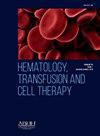神经元特异性烯醇化酶阳性卵巢中级间质细胞瘤1例
IF 1.6
Q3 HEMATOLOGY
引用次数: 0
摘要
目的卵巢上皮间质细胞瘤(SLCTs)是一种罕见的性索间质肿瘤,占卵巢原发性肿瘤的不到0.5%。它们最常见于青少年和年轻女性,可表现为各种症状,包括腹痛、可触及的肿块,在某些情况下还会出现激素失衡的迹象。虽然肿瘤标志物如癌抗原125 (CA-125)可能升高,但神经元特异性烯醇化酶(NSE)通常与这些肿瘤无关。结果一名14岁女孩,表现为弥漫性腹痛和突发性腹胀。实验室检测显示CA-125升高(65.3 U/mL,正常:0-35 U/mL), NSE升高(13.7µg/L,正常:0-12.4µg/L)。影像学检查,包括经腹盆腔超声和腹部计算机断层扫描(CT),显示一个大的23厘米的右侧卵巢肿块,以实性为主,但局灶性囊性成分,提高对恶性肿瘤的怀疑。考虑到肿瘤的大小和特点,我们进行了保留生育能力的右侧输卵管卵巢切除术和椎旁腹膜后淋巴结活检。组织病理学检查证实为中等级别的支持-间质细胞瘤,有丝分裂象频繁,但无坏死。结论该病例是第一例与血清NSE水平升高相关的SLCT病例。虽然NSE主要被认为是神经内分泌肿瘤和小细胞肺癌的标志物,但在本病例中其升高引起了对其在slct中的潜在作用的质疑。这一发现表明需要进一步的研究来确定NSE是否可以作为诊断或监测slct的有用生物标志物。考虑到这些肿瘤的罕见性和其肿瘤标志物谱的有限数据,需要进一步的研究来探索NSE升高在slct中的临床意义。本文章由计算机程序翻译,如有差异,请以英文原文为准。
NEURON SPECIFIC ENOLASE POSITIVE OVARIAN INTERMEDIATE GRADE SERTOLI LEYDIG CELL TUMOR: A RARE CASE REPORT
Objective
Ovarian Sertoli-Leydig Cell Tumors (SLCTs) are rare sex cord-stromal tumors, accounting for less than 0.5% of all primary ovarian tumors. They are most commonly diagnosed in adolescents and young women and can present with a variety of symptoms, including abdominal pain, a palpable mass, and, in some cases, signs of hormonal imbalance. While tumor markers such as Cancer Antigen-125 (CA-125) may be elevated, Neuron-Specific Enolase (NSE) is not typically associated with these tumors.
Results
A 14-year-old girl presented with diffuse abdominal pain and sudden abdominal distension. Laboratory tests revealed elevated CA-125 (65.3 U/mL, normal: 0–35 U/mL) and NSE (13.7 µg/L, normal: 0–12.4 µg/L). Imaging studies, including transabdominal pelvic ultrasound and abdominal Computed Tomography (CT), demonstrated a large, 23 cm right ovarian mass with predominantly solid but focal cystic components, raising suspicion for malignancy. Given the tumor’s size and characteristics, a fertility-sparing right salpingo-oophorectomy and paravertebral retroperitoneal lymph node biopsies were performed. Histopathological examination confirmed an intermediate-grade Sertoli-Leydig cell tumor with frequent mitotic figures but no necrosis.
Conclusion
This case is notable as the first reported instance of an SLCT associated with elevated serum NSE levels. While NSE is primarily considered a marker for neuroendocrine tumors and small cell lung carcinoma, its elevation in this case raises questions about its potential role in SLCTs. This finding suggests a need for further research to determine whether NSE could serve as a useful biomarker in the diagnosis or monitoring of SLCTs. Given the rarity of these tumors and the limited data on their tumor marker profiles, additional studies are needed to explore the clinical significance of NSE elevation in SLCTs.
求助全文
通过发布文献求助,成功后即可免费获取论文全文。
去求助
来源期刊

Hematology, Transfusion and Cell Therapy
Multiple-
CiteScore
2.40
自引率
4.80%
发文量
1419
审稿时长
30 weeks
 求助内容:
求助内容: 应助结果提醒方式:
应助结果提醒方式:


